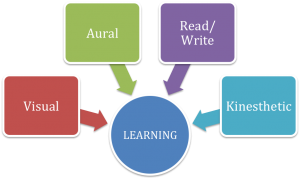
There are said to be four different learning styles. Developed by Neil Fleming in 1987, VARK encompasses these different styles which include: visual, aural/auditory, read/write, and kinesthetic. Some people have more dominant styles than others and can also develop new styles — It’s not necessarily a fixed thing.
Just as life has many modes and phases, there are exceptions to learning styles. According to VARK Learn, an additional category, multi-modal, includes people who “do not have a standout mode with one preference score well above other scores.”
As mentioned in the VARK Learn article, visual learning does not necessarily encompass written words, but rather the “depiction of information in maps, spider diagrams, charts, graphs, flow charts, labelled diagrams, and all the symbolic arrows, circles, hierarchies, and other devices, that people use to represent what could have been presented in words.” Learners with this style may prefer something like a Powerpoint presentation with graphs or moving graphics, as opposed to a traditional spoken lecture.
Aural learners prefer information that is heard/spoken. They learn best from spoken lectures, saying things aloud or discussing them with someone, and email, which is included here because “although it is text and could be included in the read/write category, it is often written in chat-style with abbreviations, colloquial terms, slang and non-formal language.” Some people who prefer to learn aurally enhance their learning by speaking aloud to themselves. They may also glean information by talking with other people. At times, they will speak aloud while thinking something rather than thinking to themselves before speaking.
People who lean toward the read/write style of learning love information displayed as words. They love a good thesaurus, dictionary, article, journal, etc. This includes reading and writing in all forms, “especially manuals, reports, essays, and assignments.” VARK Learn states that this can be beneficial, as “being able to write well and read widely are attributes sought by employers of graduates.”
The last style of learning, kinesthetic, “refers to the ‘perceptual preference to the use of experience and practice (simulated or real),’” as explained in the above article. These learners like figuring out things by doing them. They are physical learners. They feed on “personal experiences, examples, practice or simulation.” They prefer case studies or movies based on real events. They would rather experience something themselves than learn from someone else’s retelling of experiences.
Talk to us on Twitter (@ProctorU) with the hashtag #VARK to let us know which style you think you are!